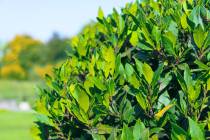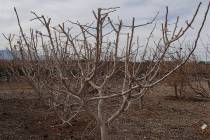Fertilizer should be applied before spring growth
Q: Last week we planted several fruit trees and have established trees as well. Would you recommend applying fertilizer around these trees now? Spikes or granular type of fertilizer?
A: Fertilizers will benefit fruit trees the most if applied to the soil just before spring growth. But if you haven’t applied any, then do it now during spring growth.
The least expensive way is using granular fertilizers in a single application in the spring. Fertilizer stakes or spikes are granular fertilizers compressed into a stake you can drive into the ground. They are not messy, are convenient and have no open bags that can spill, but more expensive per pound of fertilizer.
Drive them into the ground near drip emitters or in the irrigation basin; one for each emitter. They release nutrients slowly. Apply them only once in the spring.
For new trees, if you mixed in good quality compost with the soil in the planting hole you can skip a fertilizer application this season. If you put a smidgen in the ground then apply a fertilizer now if you haven’t.
You can split granular fertilizer applications in half if you want. Apply half now and the other half after you harvest or in a couple of months if there is no fruit. Fruit trees that are tender to winter cold should not be fertilized after midsummer, so apply the second half earlier than this.
If you are using an organic fertilizer that releases nutrients slowly then apply it once in the early spring.
Foliar sprays of fertilizers are a great way to fertilize trees if they are in difficult places. Foliar applications should be done more frequently because their results are short-lived. Apply foliar sprays every six to eight weeks until it gets hot.
Keep fertilizers away from tree trunks but in contact with water. Apply them no closer than a foot from the trunk and just under the soil surface. Make sure they are watered in thoroughly after application.
I have seen new trees killed by applications of fertilizers applied too close to the trunk. Salt damage from fertilizers can kill newly planted trees.
Don’t forget iron. Newly planted trees normally don’t need it the first couple of years but may develop iron shortages beginning in the third to the fifth years.
Q: Our saguaro is about 10 years old. In the past year or so, four arms have popped out mostly on one side. Now the saguaro is beginning to lean and we have propped it up. What do you suggest we do?
A: I would guess your irrigation is too close to the trunk. This concentrates the roots there and doesn’t allow root development further from the trunk for support.
In the wild, saguaros roots are about 30 inches deep near the trunk and spread a distance equal to its height at depths averaging only about 10 inches. This matting of shallow roots spreading from the trunk is important in keeping the cactus erect.
I would prop it up as you are doing and immobilize the base so it cannot move. Then I would apply water at increasing distances from the trunk. These should be shallow and infrequent irrigations at distances from the trunk equal to at least half of its height.
You can do this by planting other desert plants that require similar types of irrigations in these areas. Water supplied to these plants will help to irrigate the saguaro. You can also do this by hand watering in these areas once a month with a spray nozzle.
Q: I have had problems with germination of peas. Placed directly in prepared soil germination has been inconsistent and I had to reseed several times. Remembering a technique I learned years ago I diluted a quart of tap water with 1/8 teaspoon of laundry ammonia and watered them with that. In two days 10 germinated, and in three days almost all came up. Have you ever heard of this technique?
A: No, I have not and that is pretty amazing! In every instance I can remember, peas have not been hard to germinate.
A technique I use with large seed like corn, peas or beans is to soak the seed in water prior to germination. I will put a small amount of fertilizer in the water as well. I would soak them for six to eight hours before planting.
This is called “pregerminating” the seed. Using this technique usually cuts off the germination time a day or two in warm soils. I also will do the same thing with garlic cloves before planting. I usually get much faster and more even emergence from the soil.
Sometimes I think garden soil is too “fluffy” and sometimes seed has a hard time staying wet enough in dry soils for good germination. Seed germinates better in a “firm” seedbed. Not hard, but firm. If you walk on it after garden soil preparation, your feet should not sink more than an inch into the soil.
Q: How many gallons should a fruit tree receive for each watering if it’s trunk is 1½ inches in diameter 24 inches above the ground?
A: Watering amounts are usually related more to the size of the canopy or total height than the trunk. Trunk size is sometimes used more for estimating how much fertilizer to apply.
That tree size would require about 10 to 15 gallons for each watering. If you are using drip emitters, you should be using four emitters in a square pattern 12 to 18 inches from the trunk. So running 3 gallon per hour emitters for one hour would equal 12 gallons.
Q: Last summer I planted one blackberry bush in my little garden plot. I got about 10 blackberries and they were delicious. The problem I have is how to prune it.
A: Blackberries can be a bit confusing at first. You are managing two stages of growth with blackberries.
Fruit this year is produced on canes that grew last year (2-year-old canes). Canes that grow this year (1-year-old canes) produce fruit next year.
When canes produce fruit, they must then be removed or pruned to the ground. The easiest way to do it is to remove them soon after you pick the fruit.
If you wait too long to prune, it can sometimes be difficult to see which canes to prune out and which ones to leave for next year.
In our climate, vigorous blackberries seldom reach the heights they can get in milder climates. However, if you have a vigorous blackberry that will get quite tall, then cut the tips off of the canes when they reach about 4 feet in height. This helps to make them stiffer and more capable of carrying a fruit load.
Some blackberries grow along the ground and others grow more erect. If the 1-year-old canes grow along the ground, then you will have to wrap them around some trellis wires. If they are fairly erect in growth you may not need to.
Bob Morris is a horticulture expert living in Las Vegas and professor emeritus for the University of Nevada. Visit his blog at xtremehorticulture.blogspot.com. Send questions to Extremehort@aol.com.























